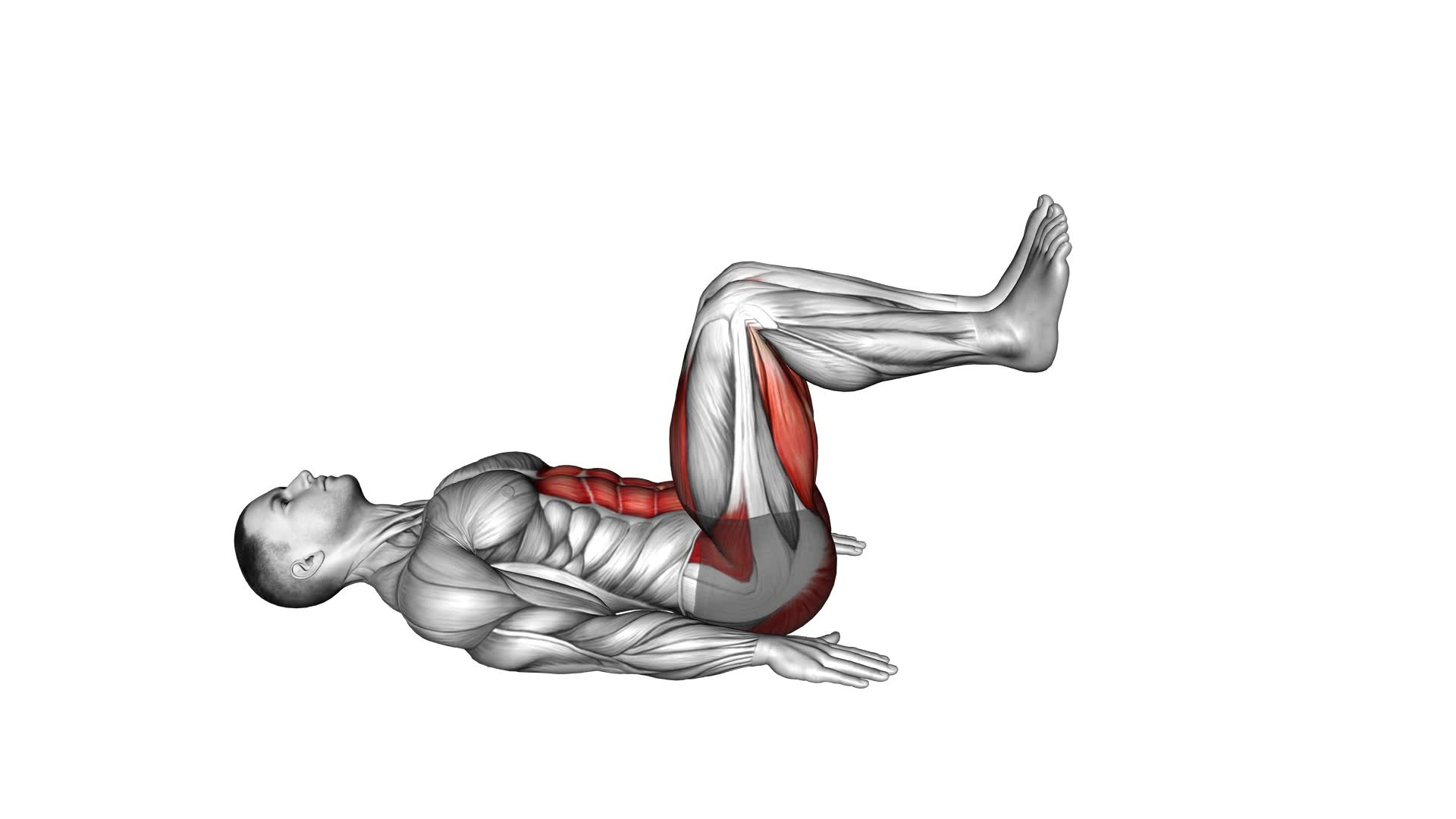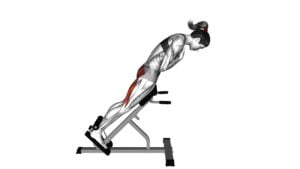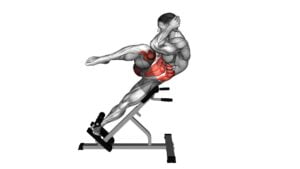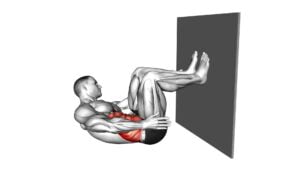Alternate Bent Leg 45 Degree Extension (Male) – Video Exercise Guide & Tips

In this video exercise guide, you'll learn all about the alternate bent leg 45 degree extension. This effective exercise targets your lower body muscles and helps improve strength and stability.
Watch This Exercise Video
With just a few pieces of equipment, you can easily incorporate this exercise into your workout routine. Watch the video and follow the proper form and technique for maximum effectiveness.
Avoid common mistakes and challenge yourself with variations and progressions.
Get ready to take your fitness to the next level!
Key Takeaways
- The alternate bent leg 45 degree extension targets lower body muscles such as quadriceps, hamstrings, and glutes.
- This exercise strengthens muscles, improves balance, and increases range of motion in the hips and knees.
- Modifications can be made to suit different fitness levels, including using different positions or adjusting weight and foot positions.
- Proper form and technique, such as engaging the core, avoiding excessive arching of the back, and controlling leg movements, are important for maximum effectiveness and to prevent injuries.
Benefits of the Alternate Bent Leg 45 Degree Extension
You can maximize your leg strength and flexibility by incorporating the alternate bent leg 45 degree extension into your workout routine. This exercise is of utmost importance as it targets the muscles in your lower body, specifically your quadriceps, hamstrings, and glutes. By performing this exercise, you can strengthen these muscles, improve your balance, and increase the range of motion in your hips and knees.
One of the key benefits of the alternate bent leg 45 degree extension is that it allows for modifications to suit different fitness levels. If you're a beginner, you can start by using lighter weights or even just your body weight until you feel comfortable and confident. As you progress, you can gradually increase the weight to continue challenging your muscles.
Another advantage of this exercise is that it can be done in various positions. You can perform it lying on your back, seated on a bench, or using a stability ball. Each position offers a slightly different challenge and engages different muscle groups, allowing for a well-rounded leg workout.
Equipment Needed for the Exercise
To perform the alternate bent leg 45-degree extension, you'll need a few pieces of equipment. The primary equipment required for this exercise is a sturdy flat bench or an exercise mat. The bench or mat will provide a stable surface for you to lie on comfortably. Additionally, you'll need a pair of dumbbells or resistance bands to add resistance to the exercise.
Using dumbbells will allow you to increase the intensity of the exercise by adding weight to your legs. Start with a weight that challenges you but still allows you to maintain proper form. Resistance bands, on the other hand, provide a different type of resistance that will engage your muscles in a slightly different way.
Having a pair of dumbbells or resistance bands will enable you to perform the alternate bent leg 45-degree extension with added resistance, enhancing the benefits of the exercise. The added resistance will help strengthen your glutes, hamstrings, and lower back muscles.
In terms of variations, you can modify the exercise by adjusting the weight of the dumbbells or resistance bands. You can also try different foot positions, such as pointing your toes inward or outward, to target different muscles. Remember to choose weights and variations that suit your fitness level and goals.
Proper Form and Technique for Maximum Effectiveness
To achieve maximum effectiveness, ensure that you maintain proper form and technique throughout the alternate bent leg 45-degree extension exercise. Proper form is crucial to target the correct muscles and prevent injury.
Start by lying flat on your back with your knees bent and feet flat on the floor. Place your hands by your sides for support. As you exhale, contract your abdominal muscles and lift your hips off the ground, creating a straight line from your knees to your shoulders. Keep your knees bent at a 45-degree angle throughout the exercise. Inhale as you slowly lower your hips back down to the starting position. Remember to breathe steadily throughout the exercise, exhaling during the contraction and inhaling during the release.
To modify the exercise, you can use a stability ball or a bench to elevate your feet. This will increase the range of motion and add an extra challenge to the exercise. Additionally, you can perform the exercise with one leg at a time for a more advanced variation.
By maintaining proper form and technique, you'll ensure that you're targeting the correct muscles and maximizing the effectiveness of the alternate bent leg 45-degree extension exercise.
Now, let's move on to the next section to learn about common mistakes to avoid while performing this exercise.
Common Mistakes to Avoid While Performing the Exercise
When performing the alternate bent leg 45 degree extension, there are a few common mistakes that you should avoid.
First, make sure to focus on maintaining proper form throughout the exercise. This includes keeping your core engaged and avoiding excessive arching of the back.
Additionally, pay attention to your breathing technique, exhaling as you extend your legs and inhaling as you bring them back in.
Form Correction Tips
To improve your form while performing the Alternate Bent Leg 45 Degree Extension exercise, focus on maintaining a strong core and controlled leg movements.
Common mistakes in this exercise include arching your back, swinging your legs, and using momentum to lift your legs instead of using your core muscles.
To correct these mistakes, start by engaging your core muscles throughout the exercise. Keep your back flat against the floor and avoid any excessive arching.
Control the movement of your legs by using your abdominal muscles to lift and lower them. Avoid swinging your legs or using momentum to lift them.
Breathing Techniques During
Use strong and controlled breathing techniques to enhance your performance and avoid common mistakes while performing the Alternate Bent Leg 45 Degree Extension exercise. Proper breathing techniques are essential to maintain exercise intensity and ensure optimal results.
As you perform this exercise, exhale during the exertion phase, which is when you lift your legs off the ground. This helps engage your core muscles and stabilize your body. Inhale as you lower your legs back down to the starting position, allowing your muscles to relax.
By coordinating your breathing with your movements, you can enhance the effectiveness of the exercise and prevent unnecessary strain on your body.
Now, let's explore the next section on avoiding excessive back arch to ensure proper form and technique.
Avoiding Excessive Back Arch
To avoid excessive back arch while performing the Alternate Bent Leg 45 Degree Extension exercise, focus on maintaining a neutral spine position throughout the movement. This is crucial for preventing lower back strain and maintaining proper alignment. Here are some key points to keep in mind:
- Engage your core muscles to support your spine and avoid overarching.
- Keep your chest lifted and shoulder blades down to promote a neutral spine.
- Avoid pushing your hips forward, as this can cause excessive arching in your lower back.
- Maintain a steady pace and avoid jerking or swinging your legs to prevent any unnecessary strain on your back.
By following these guidelines, you can ensure that you perform the exercise with proper form, reducing the risk of injury and optimizing the benefits.
Now, let's explore some variations and progressions to challenge yourself further.
Variations and Progressions to Challenge Yourself
Challenge yourself with different variations and progressions of the Alternate Bent Leg 45 Degree Extension exercise. By incorporating these progression variations and advanced modifications, you can take your workout to the next level and continue to challenge your muscles.
One variation you can try is the Single-Leg Alternate Bent Leg 45 Degree Extension. This variation involves extending one leg at a time while keeping the other leg bent at a 45-degree angle. This places more emphasis on each leg individually and increases the difficulty of the exercise.
Another progression to consider is the Weighted Alternate Bent Leg 45 Degree Extension. By adding weight, such as holding a dumbbell or using a resistance band, you increase the resistance and challenge your muscles even further. Start with a lighter weight and gradually increase as you become stronger and more comfortable with the exercise.
For those looking for an advanced modification, the Explosive Alternate Bent Leg 45 Degree Extension is a great option. This involves exploding up into the extension position and then controlling the descent back down. This explosive movement engages fast-twitch muscle fibers and adds an element of power to the exercise.
Remember to always maintain proper form and technique when performing these variations and progressions. Start with a weight and difficulty level that's appropriate for your fitness level and gradually increase as you become stronger. Challenge yourself, but never sacrifice form for intensity.
Tips for Incorporating the Exercise Into Your Workout Routine
When incorporating the Alternate Bent Leg 45 Degree Extension into your workout routine, focus on maintaining proper form and technique. This exercise targets the glutes and hamstrings, helping to strengthen and tone these muscle groups.
To get the most out of this exercise and maximize your results, consider the following tips:
- Start with a light weight or no weight at all, especially if you're new to this exercise. This will allow you to focus on form and technique before adding additional resistance.
- Incorporate modifications to cater to your fitness level. For beginners, you can perform the exercise with both feet on the ground instead of elevating one leg. As you progress, you can gradually increase the height of the leg elevation.
- Keep your core engaged and your back flat against the floor throughout the movement. This will help to prevent any excessive arching of the lower back and maintain proper alignment.
- Track your progress by keeping a workout log or using a fitness app. This will enable you to see your improvements over time and adjust your weights and repetitions accordingly.
Frequently Asked Questions
How Many Repetitions and Sets Should I Do for the Alternate Bent Leg 45 Degree Extension?
To determine how many sets and reps you should do for the alternate bent leg 45 degree extension, it's important to consider your fitness goals and current level of strength.
Generally, a good starting point is to perform 3 sets of 12-15 repetitions. However, if you're a beginner or have limited strength, you may want to start with fewer reps and sets.
Remember to maintain proper form throughout the exercise by keeping your core engaged and your back flat against the floor.
Can I Do This Exercise if I Have a Knee Injury?
Yes, you can do this exercise if you have a knee injury, but modifications are necessary.
Instead of extending your leg to a 45-degree angle, try a smaller range of motion that doesn't cause pain or discomfort.
You can also use resistance bands or ankle weights to decrease the load on your knee.
Alternatively, you can try other exercises like hamstring curls or seated leg extensions that put less strain on the knee joint.
Is It Normal to Feel a Burning Sensation in My Glutes While Performing This Exercise?
Feeling a burning sensation in your glutes during the alternate bent leg 45 degree extension is normal. It indicates that your glute muscles are being engaged and worked effectively. However, if the burning sensation becomes too intense or is accompanied by sharp pain, it may be a sign of improper form or technique.
To perform this exercise correctly, maintain proper alignment, avoid arching your back, and ensure that your glutes are doing the majority of the work.
Can I Use Ankle Weights to Make the Exercise More Challenging?
Yes, you can definitely use ankle weights to make the exercise more challenging. Adding ankle weights can increase the resistance and intensity of the movement, which can help to further strengthen and tone your glutes. It's important to choose the appropriate weight that allows you to maintain proper form and technique throughout the exercise.
Additionally, there are various variations of the alternate bent leg 45 degree extension that you can explore to target your glutes from different angles and maximize your results.
What Muscles Does the Alternate Bent Leg 45 Degree Extension Primarily Target?
During the alternate bent leg 45 degree extension, several muscles are primarily targeted. The exercise mainly activates the gluteus maximus, which is the largest muscle in the buttocks. Additionally, the hamstrings, quadriceps, and hip flexors are also engaged to stabilize the movement.
To make the exercise more challenging, you can incorporate variations and modifications such as using ankle weights or increasing the range of motion. These adjustments will further enhance muscle activation and increase the overall intensity of the exercise.
Conclusion
Incorporating the alternate bent leg 45 degree extension into your workout routine can provide numerous benefits. This exercise targets the glutes, hamstrings, and lower back, helping to strengthen and tone these muscles.
By using proper form and technique, you can maximize the effectiveness of this exercise. Avoiding common mistakes and challenging yourself with variations and progressions can further enhance your results.
Add this exercise to your routine for a more well-rounded and challenging workout.

Author
Years ago, the spark of my life’s passion ignited in my mind the moment I stepped into the local gym for the first time. The inaugural bead of perspiration, the initial endeavor, the very first surge of endorphins, and a sense of pride that washed over me post-workout marked the beginning of my deep-seated interest in strength sports, fitness, and sports nutrition. This very curiosity blossomed rapidly into a profound fascination, propelling me to earn a Master’s degree in Physical Education from the Academy of Physical Education in Krakow, followed by a Sports Manager diploma from the Jagiellonian University. My journey of growth led me to gain more specialized qualifications, such as being a certified personal trainer with a focus on sports dietetics, a lifeguard, and an instructor for wellness and corrective gymnastics. Theoretical knowledge paired seamlessly with practical experience, reinforcing my belief that the transformation of individuals under my guidance was also a reflection of my personal growth. This belief holds true even today. Each day, I strive to push the boundaries and explore new realms. These realms gently elevate me to greater heights. The unique combination of passion for my field and the continuous quest for growth fuels my drive to break new ground.







